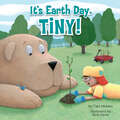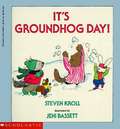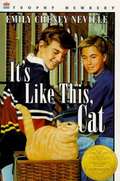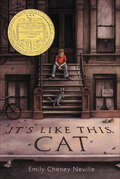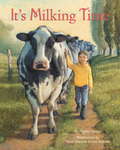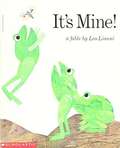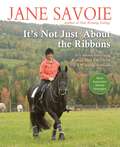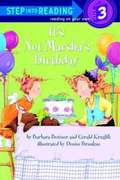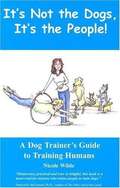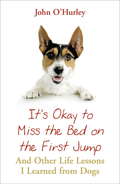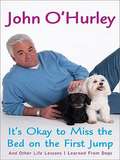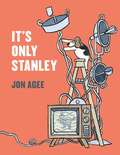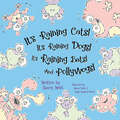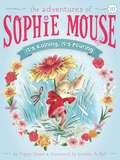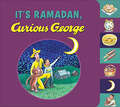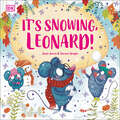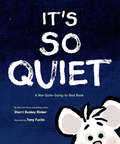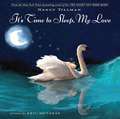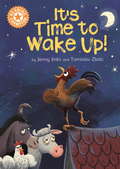- Table View
- List View
It's April Fools' Day!
by Steven KrollFrom the dust jacket: "Horace thinks of Alice as his only friend. But he doesn't act friendly. Instead, he acts like a bully. "Oh, Horace, you are so mean!" Alice complains. On April Fools' Day, Alice is scared to leave her house. She knows Horace will be waiting, ready to play mean tricks. And he does. When she goes outside, he spills a pail of water on her, pulls her tail, and chases her around the block. Alice has had enough! She decides to get even with Horace. She dreams up some tricks of her own to play on him. When he has recovered, Horace learns something about what it really means to be friends." Most pictures are described.
It's Earth Day, Tiny! (Tiny)
by Cari MeisterCelebrate Earth Day with Tiny in this fun 8x8!It's Earth Day, and Tiny and Elliott are on their way to the park, picking up litter and throwing it in the trash. At the park, a friend asks for help transporting trees to plant. But when they discover there aren't any shovels for digging, they're not sure what to do! Can Tiny find a way to save the day and help the planet?
It's Groundhog Day!
by Steven KrollSherwood Squirrel, Penelope Porcupine, and Reginald Rabbit were excited because Godfrey Groundhog thought that when he woke up on February 2nd he would not see his shadow. Roland Raccoon does not want winter to end, and Godfrey needs his friends to help him! Includes picture descriptions.
It's Like This, Cat
by Emily Cheney NevilleMy father is always talking about how a dog can be very educational for a boy. This is one reason I got a cat.<P><P> Dave Mitchell and his father yell at each other a lot, and whenever the fighting starts, Dave's mother gets an asthma attack. That's when Dave storms out of the house. Then Dave meets Tom, a strange boy who helps him rescue Cat. It isn't long before Cat introduces Dave to Mary, a wonderful girl from Coney Island. Slowly Dave comes to see the complexities in people's lives and to understand himself and his family a little better.<P> Newbery Medal Winner
It's Like This, Cat (Contemporary Scene Ser.)
by Emily Cheney NevilleThe Newbery-winning classic novel about a young New Yorker who figures out the world on his own terms with the help of one prickly tomcat, for readers who enjoy such books as Al Capone Does My Shirts and Hoot. Dave Mitchell and his father disagree on almost everything—and every time their fighting sets off his mother’s asthma, Dave ends up storming out of the house. But when Dave meets a big, handsome tomcat, he decides to bring him home, no matter what his father has to say about it.With adventure-loving Cat around, Dave meets lots of new people—like Tom, a young dropout on his own in the city, and Mary, the first girl he can talk to like a real person.And as his eyes open to those around him, Dave starts to understand his father a little better. They still don’t see eye-to-eye on a lot of things, but there is one thing they can both agree on: Having a cat can be very educational—especially when it’s one like Cat.
It's Me Hippo!
by Mike ThalerFrom the book: Hippo opened his eyes. The river felt good. The sun felt good and he felt wonderful. He skipped off to find one of his friends. There is something new to do each day for Hippo and his friends. When Hippo wants to make a house, his friends are there to give him advice. When he paints a picture, his friends are ready with more advice. And when Hippo has a birthday, his friends plan a special surprise. Includes Picture Descriptions. Other books about Hippo are available from Bookshare.
It's Milking Time
by Steve Johnson Lou Fancher Phyllis AlsdurfA lyrical and visual treasure--perfect for reading aloud to any child who's ever asked: Where does milk come from?As the sun sets over the fields, a little girl and her father begin the evening milking. They work side by side, fanning out beds of straw, bringing in the cows, and hooking up the milkers.Soon they've filled milk can after milk can for the creamery truck that will arrive in the morning. The fresh dairy product isn't just for them--other families will buy their milk, butter, and cheese at stores and farmers' markets near and far, connecting the little girl's farm to the world beyond.Phyllis Alsdurf has created a poetic story that lovingly depicts the special bond between a child and her father, as well as the relationship between a young farmer and her animals. With Steve Johnson and Lou Fancher's exquisite illustrations, It's Milking Time is a must-have for any picture book collection.A natural read-aloud selection for fans of Jane Yolen's Owl Moon.
It's Mine!
by Leo LionniThree green frogs learn a lesson about being greedy and the importance of depending upon each other, with the help of a toad who lives on the same island they do. Leo Lionni, has won awards for his artistry in the United States and Worldwide. The scanner has added beautifully detailed descriptions of Leo Lionni's illustrations which will add to a child's enjoyment of this book.
It's Not Easy Being A Bunny
by Marilyn Sadler"P. J. Funnybunny is tired of being a bunny. He is sure it would be more fun to be a bear or a bird, a possum or a pig. But which animal will he finally choose to be? Part of the Cat in the Hat series of Beginning readers. The simplicity of text, illustrations, and concepts makes this a perfect book for very beginning readers. Children will want to read it again and again-and they really can, all by themselves."
It's Not Just About the Ribbons
by Jane SavoieOver 15 years ago, Jane Savoie wrote the first book to recognize the importance of training the mind and shaping attitude in order to achieve higher levels of riding skill than ever imagined. Riders who benefited from the lessons inThat Winning Feeling!clamored for more, and Savoie responded with her fabulous follow-up book,It's Not Just About the Ribbons.Once again, Savoie shares the tools and ideas for self-improvement that she has used, not only to help herself deal with challenges, but her students—who range from Olympic contenders to intermediate riders—as well. Full of shining examples of the success of Savoie&’s methods of dealing with riding&’s—and life&’s—challenges, this book is essential for anyone who is passionate about horses but may be struggling, at some level or other, with negative emotions and frustration from slow development of riding skills. All readers will find that, with Savoie&’s contagious enthusiasm along for the ride, they too can make changes more easily and playfully while better enjoying every moment with their horses.
It's Not Marsha's Birthday
by Barbara Bottner Gerald KruglikWill Lulu get her birthday wish, or will she spend it having everyone love her baby sister, and the lions, and the seals, and everyone but her?
It's Not the Dogs, It's The People!
by Nicole WildeFrom the Book Jacket: It's Not the Dogs, It's the People!" ...If you have ever uttered that phrase, this book is for you! As a pet dog trainer, you have learned skills and mastered techniques that enable you to train dogs successfully. The good news is, you can do the same with your human clients! Discover powerful, practical techniques you can apply immediately. Learn to handle difficult personality types, from Argumentative Al to Bland Betty, from Look-at-Me Leah to Know-It-All Ned. Become adept at managing situations like emotional blackmail, unrealistic expectations, TWI (Training While Intoxicated), tardiness, haggling and more. Chapters Include: Basic Human-Training Skills Family Dynamics Working with Kids Training Hordes of Wild Humans Dealing with Difficult Personality Types Sticky Situations Personal Safety "Terrific! Insightful, witty, packed full of useful information and rooted in compassion. Nicole's book will benefit novice as well as professional dog trainers and as a result, clients and dogs alike. I can't recommend this book highly enough! " - Paul Owens, author of The Dog Whisperer: A Compassionate, Nonviolent approach to Dog Training
It's OK to Miss the Bed on the First Jump
by John O'HurleyCharming and hilarious, IT'S OK TO MISS THE BED ON THE FIRST JUMP is more than a mere celebration of man's best friend. In this lighthearted and reflective exploration of how dogs have served as some of our most valuable and enlightened teachers, well-known and well-loved actor John O'Hurley (Seinfeld, Dancing with the Stars) shares lessons learned from his life with canine companions, including: Every 15 Minutes Is a New Day; When One Person Stops Petting You, Move On; and You're Only as Big as You Think You Are, to name a few. 'Dogs, after all, have pure hearts, trusting natures, a zest for living, noble characters, and an ability to take things in stride,' writes O'Hurley in the book's introduction. 'They can be counted on, and are pleasant companions. They know what's important, always. How many humans do you know about which you could say the same?' Both poignant and laugh-out-loud funny, IT'S OK TO MISS THE BED ON THE FIRST JUMP is an ideal gift for the dog lover in your life.
It's OK to Miss the Bed on the First Jump
by John O'hurleyCharming and hilarious, IT'S OK TO MISS THE BED ON THE FIRST JUMP is more than a mere celebration of man's best friend. In this lighthearted and reflective exploration of how dogs have served as some of our most valuable and enlightened teachers, well-known and well-loved actor John O'Hurley (Seinfeld, Dancing with the Stars) shares lessons learned from his life with canine companions, including: Every 15 Minutes Is a New Day; When One Person Stops Petting You, Move On; and You're Only as Big as You Think You Are, to name a few. 'Dogs, after all, have pure hearts, trusting natures, a zest for living, noble characters, and an ability to take things in stride,' writes O'Hurley in the book's introduction. 'They can be counted on, and are pleasant companions. They know what's important, always. How many humans do you know about which you could say the same?' Both poignant and laugh-out-loud funny, IT'S OK TO MISS THE BED ON THE FIRST JUMP is an ideal gift for the dog lover in your life.
It's Okay to Miss the Bed on the First Jump
by John O'HurleyA charming and hilarious New York Times bestseller about the enduring wisdom of dogs, from the host of the enormously popular National Dog Show It's Okay to Miss the Bed on the First Jump is more than a mere celebration of man's best friend. In this lighthearted exploration of how and why dogs serve as some of our most valuable and enlightened teachers, well-known and well-loved actor/show host John O'Hurley shares lessons learned from his life with canine companions, including: *Every 15 Minutes Is a New Day *Never Miss a Nap *When One Person Stops Petting You, Move On *A Cold Can of Meat Is Still a Feast *You're Only as Big as You Think You Are "Dogs, after all, have pure hearts, trusting natures, a zest for living, noble characters, and an ability to take things in stride," writes O'Hurley in the book's introduction. "They can be counted on, and are pleasant companions. They know what's important, always. How many humans do you know about which you could say the same?" At once poignantly moving and laugh-out-loud funny, It's Okay to Miss the Bed on the First Jump is a must read for dog lovers everywhere.
It's Only Stanley
by Jon AgeeFans of Jon Klassen and Oliver Jeffers will love this mischievously funny read-aloud from award-winning author/illustrator Jon AgeeMysterious noises keep waking up the Wimbledon family. "That's very odd," says Mr. Wimbledon each time, but when he returns from checking on the sounds, he's always reassuring: "It's only Stanley; he's fixing the oil tank." "It's only Stanley; he's clearing the bathtub drain."But what Stanley the dog is actually doing while his oblivious family goes back to bed is deliciously absurd: he's turning the house into a rocket ship to zoom himself and his family to another planet for an alien encounter. This is a perfect rhyming read-aloud for fans of irreverent tales like Click Clack Moo and I Want My Hat Back.
It's Only Stanley (Into Reading, Read Aloud Module #2)
by Jon AgeeNIMAC-sourced textbook <P><P>Fans of Jon Klassen and Oliver Jeffers will love this mischievously funny read-aloud from award-winning author/illustrator Jon Agee <P><P>Mysterious noises keep waking up the Wimbledon family. "That's very odd," says Mr. Wimbledon each time, but when he returns from checking on the sounds, he's always reassuring: "It's only Stanley; he's fixing the oil tank." "It's only Stanley; he's clearing the bathtub drain." <P><P>But what Stanley the dog is actually doing while his oblivious family goes back to bed is deliciously absurd: he's turning the house into a rocket ship to zoom himself and his family to another planet for an alien encounter. This is a perfect rhyming read-aloud for fans of irreverent tales like Click Clack Moo and I Want My Hat Back.
It's Raining Cats! It's Raining Dogs! It's Raining Bats! And Pollywogs!
by Sherry WestOne very unusual day, it rains, but not the kind that&’s expected . . .&“The heavens opened and down they sent one quite noisy elephant!&”And so, begins a very hilarious downpour of confused, amused, bemused, grumpy, frumpy, mumpy, lumpy, highly annoyed, and patiently suffering zoo full of animals onto an unseen town down below!&“We have to duck and run for cover while chickens cluck and near us hover! They&’re raining fast all over town! I wonder what else is coming down???&”Parents and educators alike enjoy reading this hilarious, highly-engaging and appealing book with its lyrical text and giggly-wiggly pictures to children, who quickly and easily acquire important language and reading skills along their merry way.
It's Raining, It's Pouring (The Adventures of Sophie Mouse #10)
by Poppy GreenSophie Mouse and her furry friends prepare for a big storm that’s headed right for Silverlake Forest in this tenth charming book of The Adventures of Sophie Mouse series!Sophie Mouse has been preparing for the first-ever Silverlake Forest Spring Fling for weeks. She has come up with activities, like a Lily Pad Dance, she’s thought of games to play, and she’s created all sorts of fun hats, masks, and other costumes for her friends to wear. But the day of the Spring Fling is approaching, and Sophie’s twitching whiskers are telling her that the rain is too! Sure enough, it rains and it pours. Will Sophie figure out a way to save the day or will all her hard work go to down the drain? With easy-to-read language and illustrations on almost every page, the Adventures of Sophie Mouse chapter books are perfect for beginning readers.
It's Ramadan, Curious George (Curious George Ser.)
by Hena Khan H. A. Rey H. A. ReyGeorge celebrates Ramadan with his friend Kareem. “A groundbreaking new book that also tries to span the cultural chasm for a new generation.” —The New YorkerGeorge helps Kareem with his first fast and joins in the evening celebration of tasting treats and enjoying a special meal. Then George helps make gift baskets to donate to the needy, and watches for the crescent moon with the man in the yellow hat. Finally, George joins in the Eid festivities to mark the end of his very first Ramadan.This playful book makes a great holiday gift for all fans of Curious George—those who celebrate Ramadan, and those who are learning about it for the first time.“To help overcome Islamophobia and foster mutual respect, acceptance and understanding, teachers, parents, community leaders and librarians can use books like these to educate children about Muslims while enhancing religious literacy.” —The Huffington Post “I hope [this book] makes it into the hands of Muslim children who need it and any child curious about Ramadan and Islam. Parents, this is how we teach love.” —Read It Real Good
It's Simple, Said Simon
by Mary Ann Hoberman Meilo SoOne day, a boy goes out for a walk. He encounters a dog, a cat, and a horse. The dog dares him to growl, the cat dares him to stretch, and the horse dares him to jump. "It's simple," says Simon. Then he meets a tiger, who challenges him to all three dares, with increasing difficulty. Will the boy best the tiger, or the tiger best the boy?From the Hardcover edition.
It's Snowing, Leonard! (Look! It's Leonard!)
by Jessie JamesFollow Leonard on the search to find his scarf during the chilly Christmas holiday!Meet Leonard, a caring little shrew, in this enchanting snowy story, as the Shrew family are off on a chilly Christmas holiday to Iceland. Most of the shrews haven&’t experienced cold, wintery weather before so when it starts to snow, they can&’t wait to go outside – especially, little Leonard! But before they can play in the snow, they must wrap up warm. But wait, where is Leonard&’s scarf? Go on a journey with Leonard as he searches for his scarf in this heartwarming picture book.This engaging children&’s story book offers:- Simple and amusing text that is ideal for children to read aloud.- Colorful, funny illustrations that bring the quirky characters to life.- A strong message about being kind and putting others first.This heart-warming picture book introduces young children to winter and has an underlying message about kindness and putting others first. It&’s Snowing, Leonard! is the ideal animal book for adults to share with their little ones.
It's So Quiet: A Not-Quite-Going-to-Bed Book
by Sherri Duskey RinkerMake some noise! Bestselling picture book stars Sherri Duskey Rinker and Tony Fucile invite you on a rollicking cumulative read-aloud perfect for bedtime or storytime!It's time for bed, but one little mouse just can't get to sleep. It's TOO QUIET! But the night is full of rhythmic sounds, from the croak of the bullfrog to the howl of a coyote on a distant hill. As the symphony of nighttime sounds builds and builds in this rollicking read-aloud, the mouse starts to wonder whether he wouldn't like a little MORE quiet.From the bestselling author of Goodnight, Goodnight, Construction Site comes a silly, noisy bedtime book that will have parents and children squealing, croaking, and laughing along—before settling themselves down for a quiet night's sleep.• BESTSELLING AUTHOR: With five #1 New York Times bestselling picture books to date, Sherri Rinker has won the hearts of millions of fans with the Goodnight, Goodnight, Construction Site series.• GREAT BEDTIME READ-ALOUD: Soft and sweet rhymes build to a hilarious nighttime chorus before settling back down to sleep. Little readers will delight in the humor and interactivity of this bedtime book, just right for a fun read-aloud that encourages appreciation of bedtime's soothing quiet.• A GO-TO BOOK FOR PARENTS: Does your child love animal noises and funny read-alouds? This book will engage even the most rambunctious readers, and become a bedtime favorite.Perfect for:• Parents, grandparents, and caregivers• Librarians• Kindergarten and elementary school teachers• Fans of Sherri Duskey Rinker
It's Time to Sleep, My Love
by Eric Metaxas"It's time to sleep, it's time to sleep," the fishes croon in waters deep. The songbirds sing in trees above, "It's time to sleep, my love, my love." As children prepare for bed, the world around them is also settling down for the night. Through the seasons, animals who live in the jungle, the forest, and the sea all whisper to their babies, and to yours, a soft refrain: "It's time to sleep, my love." As warm as a good night hug, this lullaby is lovingly brought to life by bestselling artist Nancy Tillman, whose illustrations celebrate the wonders of the natural world, and the bonds of family.
It's Time to Wake Up!: Independent Reading Orange 6 (Reading Champion #472)
by Jenny JinksThis story is part of Reading Champion, a series carefully linked to book bands to encourage independent reading skills, developed with Dr Sue Bodman and Glen Franklin of UCL Institute of Education (IOE)Cluck the cockerel knows his job on the farm is very important: he must wake all the other animals to do their work! The only problem is ... Cluck has no idea when he should crow! This funny and heart-warming story shows the value of kindness and helping a friend in need.Reading Champion offers independent reading books for children to practise and reinforce their developing reading skills.Fantastic, original stories are accompanied by engaging artwork and a reading activity. Each book has been carefully graded so that it can be matched to a child's reading ability, encouraging reading for pleasure.

